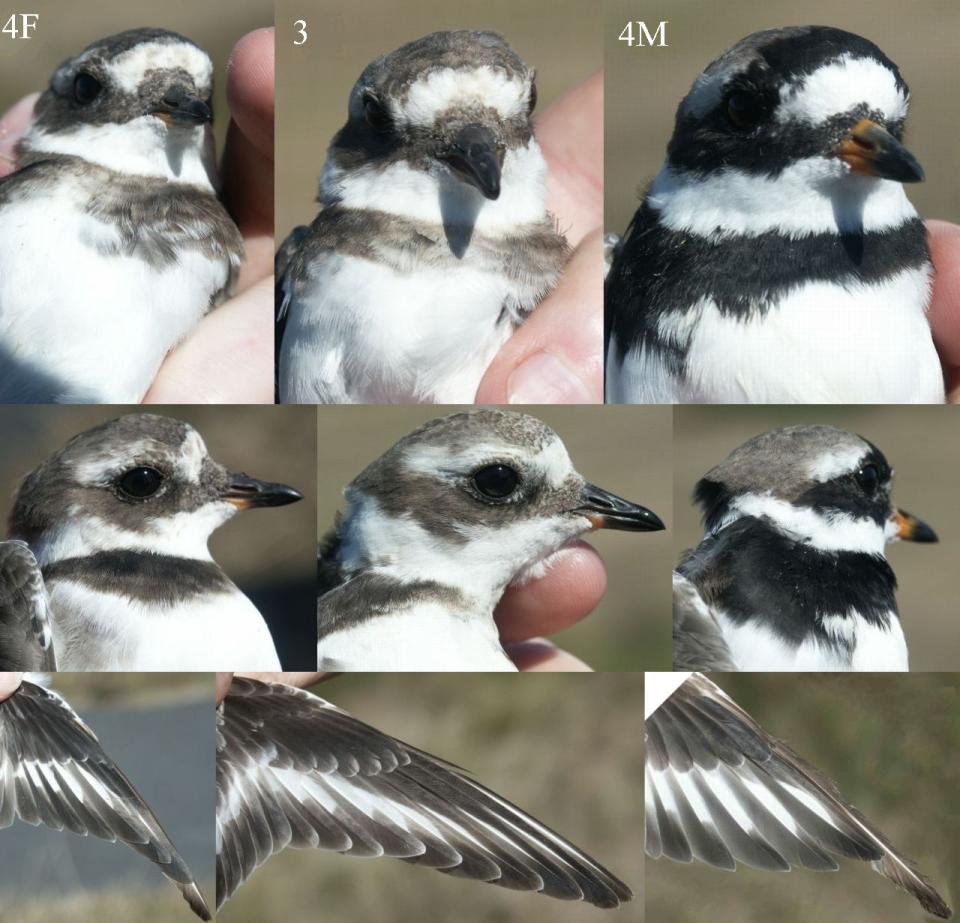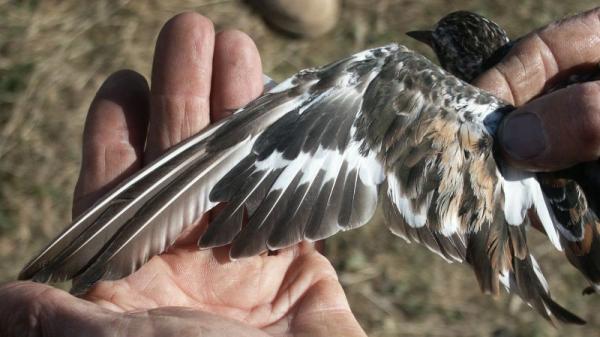Ringed Plover and Turnstone (Walney Island) (30 August 2003)
Courtesy of Jack Sheldon and the Morecambe Bay Wader Group, a number of MRG members took part in the cannon-netting attempt at 'Coastguards' on the west side of Walney Island, 30 August 2003. There was only a small catch, 5 Ringed Plovers Charadrius hiaticula and a Turnstone Arenaria interpres, but the Ringed Plovers were five of the most interesting we could have wished for (apart from getting some already wearing rings). Not being overwhelmed with birds or troubled by the weather, we were all able to enjoy and learn as much as we could from these five. Three of them were of the local British (nominate) race Charadrius hiaticula hiaticula: an adult male and an adult female, both coming towards the end of their primary moult and a juvenile with a very scaly look, caused by the light-coloured fringing to all of its contour feathers. The other two birds were of the Arctic-breeding race Charadrius hiaticula tundrae. These do not moult here but fatten up and pass through to moult and winter in west Africa. One was an adult male with a fat score of 2 (out of 8), and the other a juvenile with fresh wing feathers but little of the obvious juvenile body feathering left, presumably because the fringes have worn off in its long flight here.
The composite photo shows the two British adults and, in the middle, the tundrae juvenile.

Many adults can be sexed by the colour and the depth of the band on the upper breast/ neck: complete and black for a male, less deep and browner for a female (as illustrated on the front cover of the first edition of the BTO Wader Guide). It is noticeable that the appearance of the neck-band changes according to whether the bird is stretching its neck or not. These two are close to the extreme ends of the variation. The female shows a very weak neck-band and also rather little yellow on the bill: from a quick glance it might be thought to be a juvenile bird but the side views of the heads show that it is more clearly marked and darker than the juvenile, and the view of the wings (below each bird) clinches it, with the juvenile's fairly fresh primaries and the remaining worn outer primary, not yet moulted, in each adult. I suspect that the left-hand bird is actually a '5' (second year) female, but there were no feathers left by which we could age her as such, so both adults just go into the books as Euring age '4'.
Unlike, for instance, Dunlin races, there is no obvious plumage difference between the Ringed Plover races, but there can be a significant size difference. Remember Bergmann's rule, that birds breeding farther north tend to have larger bodies. This is all to do with minimising heat loss in the colder climates: heat loss is proportional to the surface area while heat generation depends on the body volume, so the larger the better. Similarly, birds from farther north tend to have smaller extremities - bills and legs - named as Allen's rule. However, with Ringed Plovers it is the opposite way round: the British birds are bigger than the Arctic-breeders. The explanation, which always sounds to me like a cop-out, is that the selection pressure comes during winter, conditions being harsher in Britain than in Africa, so the birds benefit from being bigger in the British winter. These birds conformed to the usual Ringed Plover size difference; indeed, the tundrae juvenile had a wing length 8 mm shorter than that of the British juvenile bird.
The Turnstone was an adult part-way through its wing moult. Most of those on the beach were well towards winter plumage, not looking very Ruddy.

David Norman.